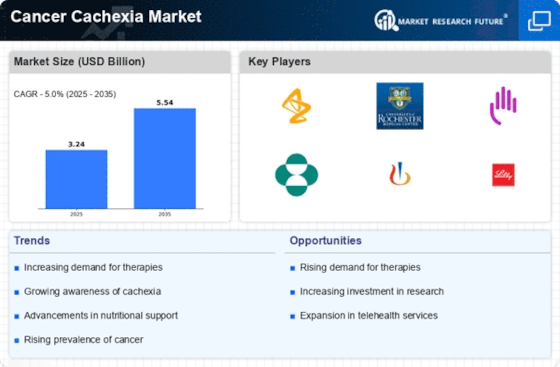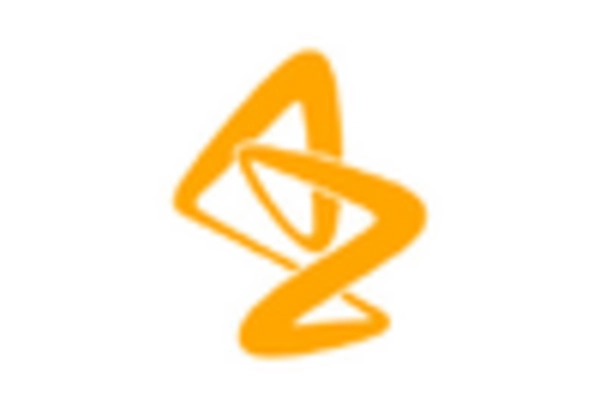Increasing Incidence of Cancer
The rising incidence of cancer worldwide is a primary driver for the Cancer Cachexia Market. As cancer cases continue to escalate, the prevalence of cachexia, a syndrome characterized by weight loss and muscle wasting, becomes more pronounced. According to recent statistics, approximately 50% of cancer patients experience cachexia, which significantly impacts their quality of life and treatment outcomes. This alarming trend necessitates the development of effective therapeutic interventions, thereby propelling the Cancer Cachexia Market forward. Pharmaceutical companies are increasingly focusing on research and development to address this unmet medical need, which is expected to result in a surge in product offerings and market growth. Furthermore, the growing recognition of cachexia as a critical component of cancer care is likely to enhance the demand for specialized treatments, thereby driving the market further.
Growing Demand for Nutritional Support
The increasing recognition of the importance of nutritional support in cancer care is driving the Cancer Cachexia Market. Cachexia often leads to malnutrition, which can adversely affect treatment outcomes and overall patient survival. As healthcare providers become more aware of the critical role that nutrition plays in managing cachexia, there is a growing demand for specialized nutritional products and interventions. The market for nutritional supplements tailored for cancer patients is expanding, with estimates suggesting a potential growth rate of over 8% annually. This trend is further supported by the integration of nutritional counseling into cancer treatment protocols, emphasizing the need for comprehensive care. Consequently, the Cancer Cachexia Market is likely to benefit from the increasing focus on nutritional strategies as a means to combat cachexia and improve patient outcomes.
Advancements in Research and Development
Ongoing advancements in research and development are pivotal to the growth of the Cancer Cachexia Market. Innovative studies are being conducted to better understand the underlying mechanisms of cachexia, leading to the identification of novel therapeutic targets. For instance, recent research has highlighted the role of inflammatory cytokines in the development of cachexia, prompting the exploration of anti-inflammatory agents as potential treatments. The market is witnessing a surge in clinical trials aimed at evaluating the efficacy of new drugs and treatment modalities. As of October 2025, the number of clinical trials focused on cachexia has increased significantly, indicating a robust pipeline of potential therapies. This influx of research not only enhances the understanding of cachexia but also fosters collaboration between academia and industry, ultimately contributing to the expansion of the Cancer Cachexia Market.
Rising Investment in Oncology Therapeutics
The surge in investment in oncology therapeutics is a significant driver for the Cancer Cachexia Market. As pharmaceutical companies recognize the economic burden associated with cancer and its complications, including cachexia, there is a concerted effort to allocate resources towards the development of effective treatments. In recent years, venture capital funding for oncology startups has reached unprecedented levels, with billions of dollars being invested in innovative therapies. This influx of capital is expected to accelerate the development of new drugs targeting cachexia, thereby expanding the treatment landscape. Additionally, partnerships between biotech firms and established pharmaceutical companies are becoming increasingly common, facilitating the sharing of expertise and resources. As a result, the Cancer Cachexia Market is poised for substantial growth, driven by the increasing financial commitment to addressing the challenges posed by cancer cachexia.
Enhanced Regulatory Support for Cachexia Treatments
Enhanced regulatory support for treatments targeting cachexia is emerging as a crucial driver for the Cancer Cachexia Market. Regulatory agencies are recognizing the urgent need for effective therapies to address this debilitating condition, leading to streamlined approval processes for cachexia treatments. Recent initiatives aimed at expediting the development and approval of drugs for serious conditions have created a more favorable environment for innovation. As of October 2025, several promising therapies are in advanced stages of clinical trials, benefiting from accelerated review pathways. This regulatory support not only encourages pharmaceutical companies to invest in cachexia research but also instills confidence in investors regarding the viability of new treatments. Consequently, the Cancer Cachexia Market is likely to experience accelerated growth as a result of these favorable regulatory developments.


















Leave a Comment